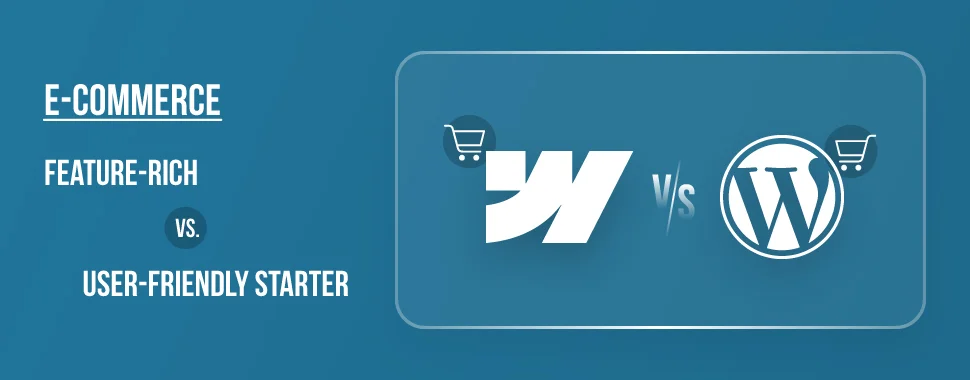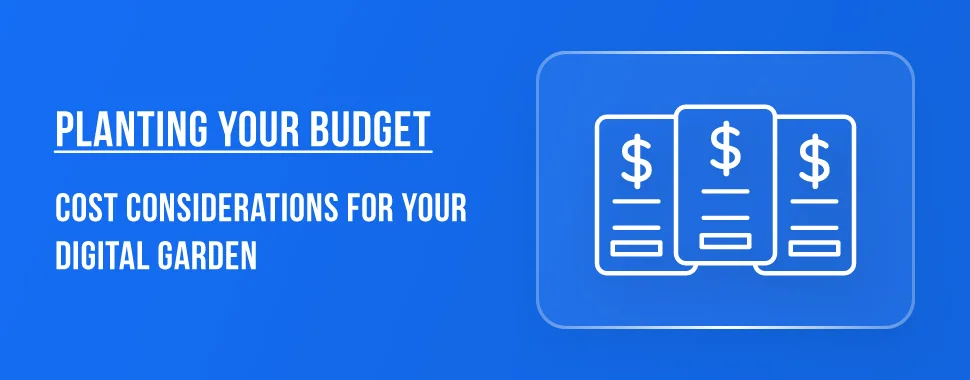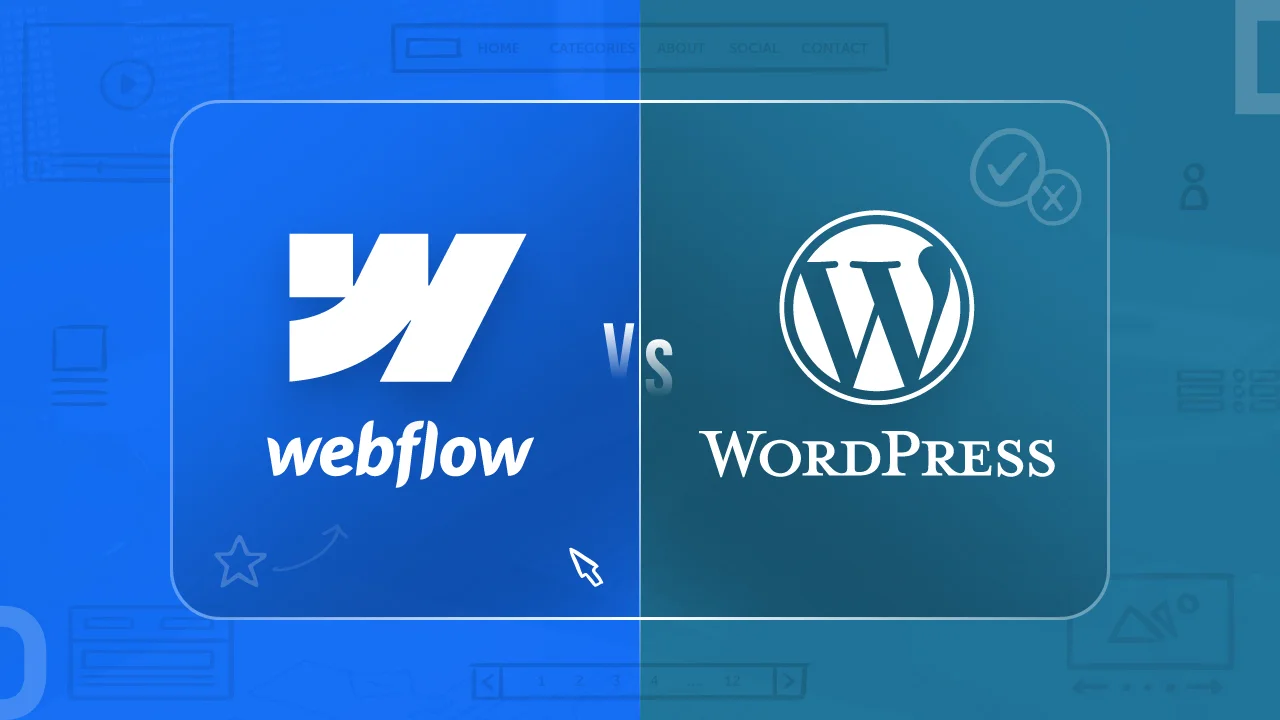The internet is your virtual orchard, a land brimming with potential for growth.
But just like in the real world, the tools you choose matter.
Picking the right platform isn’t just about aesthetics, it’s about nurturing your online presence and reaping the fruits of your labor.
It’s always a battle – WordPress vs Webflow! Who’s more powerful and power-packed with features?
Webflow, the perfectionist artisan! Consider Webflow as a master blacksmith, forging pixel-perfect websites with precise control.
Every detail, from subtle animations to complicated interactions, is carefully crafted by your hand. This platform empowers design enthusiasts and developers, offering the freedom to sculpt captivating masterpieces.
But be warned, just like wielding a hammer requires skill, Webflow demands a deeper understanding of web development.
WordPress, the vibrant marketplace! Consider WordPress as a bustling farmers market, overflowing with pre-built themes and plugins – your pick of the harvest!
This user-friendly platform caters to content creators and beginners, offering an intuitive interface and an abundance of tools to get you started quickly.
Like picking delicious, ready-to-eat fruits, WordPress prioritizes ease of use over complete design control.
Design Conundrums: Pixel-Perfect Precision vs. Theme-Driven Freedom
![]() Design-focused people have to decide which platform to use based on a basic question: pre-made themes with little room for customization, or total creative control with a more difficult learning curve?
Design-focused people have to decide which platform to use based on a basic question: pre-made themes with little room for customization, or total creative control with a more difficult learning curve?
WordPress provides a method that is theme-driven. Its large library offers a variety of designs, but deeper modifications frequently require coding expertise for personalization.
Though perfect for speedy launches, the chosen theme ultimately limits design options. Conversely, webflow enables pixel-perfect accuracy.
With its sophisticated visual editor, you can carefully shape each component, giving you unparalleled artistic flexibility.
However, it is less beginner-friendly because mastering these techniques takes committed study and work.
Decision is yours: wordpress for better themes and webflow for pixel perfection!
Scalability: Which is Better – Content or Design?
WordPress reigns supreme for content-driven websites, primarily due to its extensive plugin ecosystem that effortlessly enhances user engagement, performance and content management. However, complications and conflicts may arise from an excessive load on these plugins.
On the other hand, Webflow demonstrates exceptional performance in visually-driven websites; its server-side architecture and clear code enable a smooth scaling experience.
For more complex features, you might require exploration beyond Webflow’s primary product line. Ultimately, your website’s primary focus – whether it is content or design – determines the scalability champion.
Therefore, make a decision after careful consideration. Choose your comfort – WordPress for content whereas webflow for design!
SEO Showdown
Webflow takes the guesswork out of fundamental optimization by providing built-in tools for titles, meta descriptions, and structured data, making SEO easier.
Advanced SEO modification, however, might call for either additional tools or programming knowledge.
WordPress, on the other hand, depends on well-known plugins like Yoast SEO and Rank Math, which offer a great deal of control but also an additional level of administration.
In the end, decide what you need: WordPress for plugin power, Webflow for built-in simplicity.
E-commerce – Feature-rich vs. User-friendly Starter
 WordPress and WooCommerce are the ideal pair for feature-rich, sophisticated e-commerce.
WordPress and WooCommerce are the ideal pair for feature-rich, sophisticated e-commerce.
WooCommerce offers innumerable customization options, variations, and subscriptions, but setup and inventory management demand additional expertise.
However, Webflow’s integrated e-commerce provides an easy entry point if you value user-friendliness for a simple online store.
Select your weapon: intuitive launch or powerful features.
Community and Support: Personalized Touch vs. Collective Wisdom
WordPress provides forums, tutorials, and a wealth of development resources for a wide range of solutions and an extensive community. However, sorting through the vast amount of information can be difficult.
Conversely, Webflow’s smaller community strengthens relationships. While the community knowledge base may be smaller, it delivers targeted information and their committed support team offers individualized assistance.
Select the advice of the masses or a helpful hand.
Going Beyond the Fundamentals: Revealing Extra Benefits – WordPress vs Webflow
While WordPress offers greater development freedom through plugins and coding, Webflow excels at making its fundamental features simple to use.
Webflow offers native integrations for marketing automation, whereas WordPress is dependent on plugins.
Both provide basic analytics; select the one that best suits your demands for data and integrations. In the end, take these things into account to make a well-rounded choice.
Planting Your Budget: Cost Considerations for Your Digital Garden

While both WordPress and Webflow offer fertile ground for your online presence, their financial models differ significantly.
WordPress beckons budget-conscious beginners with its free-to-use core platform. Dive in and explore themes and plugins galore, but remember – additional features and hosting will blossom into ongoing costs.
For a streamlined experience, Webflow presents comprehensive paid plans, encompassing essential tools and hosting in one tidy package. While this convenience might require a larger initial investment, it can simplify budgeting and eliminate worries about managing separate services.
Ultimately, the ideal financial approach depends on your needs and resources.
————————————————————————————————————————————————————————-
Are you cost-conscious, seeking a low-barrier entry point?
Start with WordPress.
————————————————————————————————————————————————————————-
Do you prefer the all-in-one convenience of a paid plan?
Webflow could be your perfect bloom.
————————————————————————————————————————————————————————-
Choose wisely, and watch your digital garden flourish!
Comparative Analysis Table for WordPress vs Webflow
| Feature/Criteria/Area | WordPress | Webflow |
|---|---|---|
| Ease of Use | User-friendly interface, may have a learning curve for beginners | Intuitive drag-and-drop interface, beginner-friendly, with a learning curve for developers |
| Customization Capabilities | Extensive customization through plugins and themes, coding often required for complex modifications | Highly customizable with a visual design interface, less reliance on coding, growing plugin ecosystem |
| Development Speed | Quick setup, extensive customization may elongate development time | Real-time visual feedback accelerates development, ideal for rapid prototyping and iteration |
| Flexibility | Vast repository of plugins and themes for diverse needs | Flexible design approach, suitable for various project scopes |
| Community Support | Massive community, constant updates, security patches, and resources | Growing community, active support, continuous improvement |
| Market Share | Commands 39.5% of the market, with over 455 million websites | Emerging platform with a growing user base of over 3.5 million websites |
| Visual Design Interface | Coding often required for complicated designs | Drag-and-drop interface for visually appealing layouts without extensive coding |
| Responsive Design | Responsive design capabilities, adapting to various devices | xcellence in creating responsive designs for optimal user experience |
| Rapid Prototyping | Limited real-time visual feedback, may require more traditional prototyping methods | Real-time visual feedback facilitates rapid prototyping and iteration |
| Learning Curve | Steeper learning curve for beginners, extensive resources available | User-friendly for designers, developers may face an adjustment period |
| Code Dependency | Extensive customization often involves delving into code | Less reliance on code for customization, providing a code-free environment for designers |
| Plugin Ecosystem | Extensive library with 58,000+ plugins | Growing plugin ecosystem, may not match the extensive library of WordPress |
| Monthly Costs | Free to $25-plus per month | $14 to $39 per month |
| Web Hosting | Requires separate purchase | Included with subscription |
| Site Editor | Visual or code-based editing | Visual interface |
| SEO Tools | Numerous plug-ins for customizable SEO features | Inclusive SEO options with subscription |
| E-Commerce | Extensive plug-in options; WooCommerce widely used | Beta version, lacks some features (starting at $29 per month) |
| Membership Sites | Available | Not presently available |
| Content Management | CMS functionality across all plans | Not included in base plan; CMS available with upgraded plan ($16 per month) |
| Customer Service | Live chat and 24/7 support on paid plans | Business hours availability, AI chatbot for common issues |
| Integrations | Abundance of plug-ins for analytics, SEO, e-commerce and security. | Extensive features within subscription; limited immediate integrations, some troubleshooting required |
Which path to choose – WordPress vs Webflow?
Let’s make your selection easy with our detailed analysis!
WordPress vs Webflow: SWOT Analysis
| Aspect | WordPress | Webflow |
|---|---|---|
| Strengths |
|
|
| Weaknesses |
|
|
| Opportunities |
|
|
| Threats |
|
|



